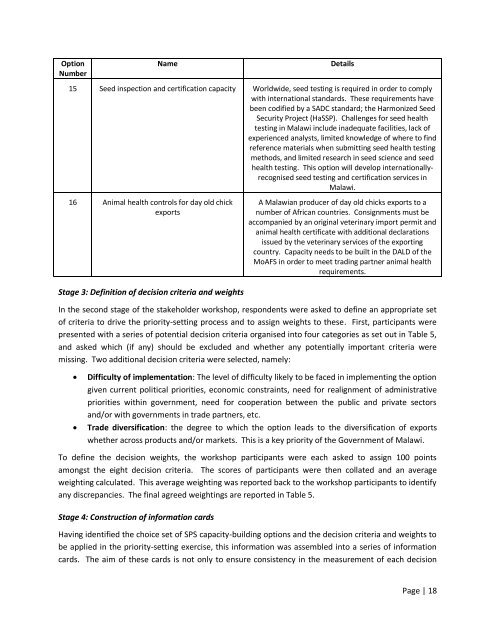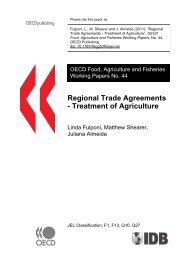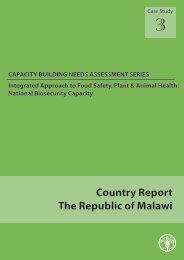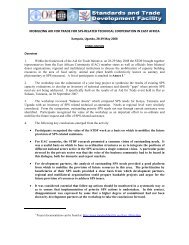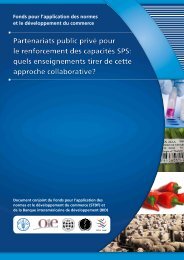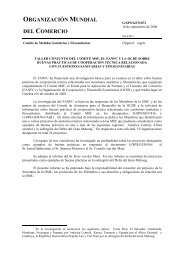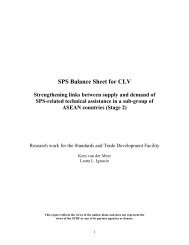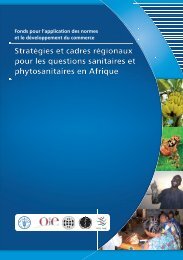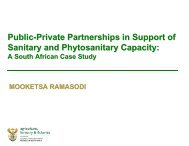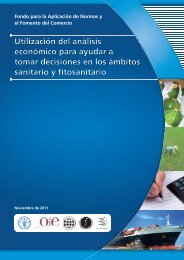MCDA Final Report Malawi - Standards and Trade Development ...
MCDA Final Report Malawi - Standards and Trade Development ...
MCDA Final Report Malawi - Standards and Trade Development ...
You also want an ePaper? Increase the reach of your titles
YUMPU automatically turns print PDFs into web optimized ePapers that Google loves.
Option<br />
Number<br />
Name<br />
Details<br />
15 Seed inspection <strong>and</strong> certification capacity Worldwide, seed testing is required in order to comply<br />
with international st<strong>and</strong>ards. These requirements have<br />
been codified by a SADC st<strong>and</strong>ard; the Harmonized Seed<br />
Security Project (HaSSP). Challenges for seed health<br />
testing in <strong>Malawi</strong> include inadequate facilities, lack of<br />
experienced analysts, limited knowledge of where to find<br />
reference materials when submitting seed health testing<br />
methods, <strong>and</strong> limited research in seed science <strong>and</strong> seed<br />
health testing. This option will develop internationallyrecognised<br />
seed testing <strong>and</strong> certification services in<br />
<strong>Malawi</strong>.<br />
16 Animal health controls for day old chick<br />
exports<br />
A <strong>Malawi</strong>an producer of day old chicks exports to a<br />
number of African countries. Consignments must be<br />
accompanied by an original veterinary import permit <strong>and</strong><br />
animal health certificate with additional declarations<br />
issued by the veterinary services of the exporting<br />
country. Capacity needs to be built in the DALD of the<br />
MoAFS in order to meet trading partner animal health<br />
requirements.<br />
Stage 3: Definition of decision criteria <strong>and</strong> weights<br />
In the second stage of the stakeholder workshop, respondents were asked to define an appropriate set<br />
of criteria to drive the priority-setting process <strong>and</strong> to assign weights to these. First, participants were<br />
presented with a series of potential decision criteria organised into four categories as set out in Table 5,<br />
<strong>and</strong> asked which (if any) should be excluded <strong>and</strong> whether any potentially important criteria were<br />
missing. Two additional decision criteria were selected, namely:<br />
<br />
<br />
Difficulty of implementation: The level of difficulty likely to be faced in implementing the option<br />
given current political priorities, economic constraints, need for realignment of administrative<br />
priorities within government, need for cooperation between the public <strong>and</strong> private sectors<br />
<strong>and</strong>/or with governments in trade partners, etc.<br />
<strong>Trade</strong> diversification: the degree to which the option leads to the diversification of exports<br />
whether across products <strong>and</strong>/or markets. This is a key priority of the Government of <strong>Malawi</strong>.<br />
To define the decision weights, the workshop participants were each asked to assign 100 points<br />
amongst the eight decision criteria. The scores of participants were then collated <strong>and</strong> an average<br />
weighting calculated. This average weighting was reported back to the workshop participants to identify<br />
any discrepancies. The final agreed weightings are reported in Table 5.<br />
Stage 4: Construction of information cards<br />
Having identified the choice set of SPS capacity-building options <strong>and</strong> the decision criteria <strong>and</strong> weights to<br />
be applied in the priority-setting exercise, this information was assembled into a series of information<br />
cards. The aim of these cards is not only to ensure consistency in the measurement of each decision<br />
Page | 18


